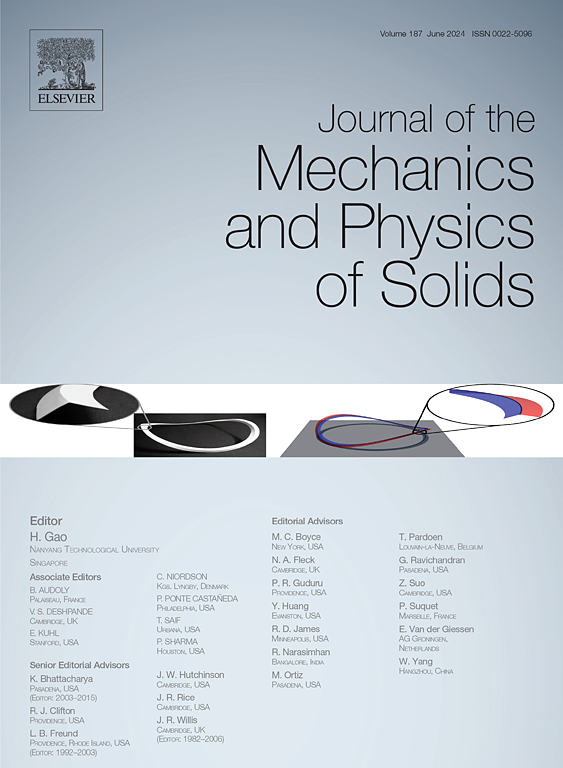Modeling of fracture in plates using a Graph-Based Finite Element Analysis (GraFEA)
IF 6
2区 工程技术
Q2 MATERIALS SCIENCE, MULTIDISCIPLINARY
引用次数: 0
Abstract
This study is focused on a thermodynamically consistent fracture model for brittle and quasi-brittle plates using a Graph-based Finite Element Analysis (GraFEA) approach. Previous studies (Srinivasa et al., 2021, Thamburaja et al. 2021) formulated a graph-based approach in two and three dimensions, implementing it in Abaqus/Explicit with a vectorized user material subroutine (VUMAT). However, conducting a three-dimensional simulation can be computationally demanding when dealing with thin structures like plates and shells, where the planar dimensions are much larger than the thickness. Hence, in this study, a model based on GraFEA, which describes the deformation kinematics of the plate using the First-order Shear Deformation Theory (FSDT), is proposed. The fundamental idea of this model is the presence of multiple microcrack planes traversing through a material point on the top and bottom surfaces of the plate. The state of a crack plane evolves based on the probabilistic description of microcracks at the top and bottom half of the plate (Srinivasa et al., 2021, Thamburaja et al. 2021). An elastic predictor -fracture corrector method and a velocity-verlet algorithm are used to solve the static and dynamic versions of the governing equations in a finite element framework. It is shown that the proposed formulation compares well with the numerical results from the GraFEA 2D and GraFEA 3D simulations as well as experimental observations from the literature at a much lower computational cost. With this model, complex fracture patterns of plates under static and dynamic loading can be simulated in a few minutes on a laptop computer as compared to several hours or days on a supercomputer for a full 3D simulation.
基于图形有限元分析(GraFEA)的钢板断裂建模
本研究的重点是利用基于图的有限元分析(GraFEA)方法建立脆性和准脆性板的热力学一致断裂模型。先前的研究(Srinivasa et al., 2021, Thamburaja et al. 2021)在二维和三维上制定了基于图形的方法,并在Abaqus/Explicit中使用矢量化用户材料子程序(VUMAT)实现。然而,在处理薄结构(如板和壳)时,进行三维模拟可能需要计算量,其中平面尺寸远大于厚度。因此,在本研究中,提出了一个基于GraFEA的模型,该模型使用一阶剪切变形理论(FSDT)来描述板的变形运动学。该模型的基本思想是存在多个微裂纹平面穿过板材的上下表面的材料点。裂纹面状态的演变基于板的上下半部微裂纹的概率描述(Srinivasa et al., 2021, Thamburaja et al. 2021)。采用弹性预测-断裂校正法和速度-verlet算法求解有限元框架中控制方程的静态和动态版本。结果表明,该公式与GraFEA 2D和GraFEA 3D模拟的数值结果以及文献中的实验观测结果相比较,计算成本低得多。有了这个模型,在静态和动态载荷下,复杂的板块断裂模式可以在几分钟内在笔记本电脑上模拟出来,而在超级计算机上进行完整的3D模拟需要几个小时或几天。
本文章由计算机程序翻译,如有差异,请以英文原文为准。
求助全文
约1分钟内获得全文
求助全文
来源期刊
CiteScore
9.80
自引率
9.40%
发文量
276
审稿时长
52 days
期刊介绍:
The aim of Journal of The Mechanics and Physics of Solids is to publish research of the highest quality and of lasting significance on the mechanics of solids. The scope is broad, from fundamental concepts in mechanics to the analysis of novel phenomena and applications. Solids are interpreted broadly to include both hard and soft materials as well as natural and synthetic structures. The approach can be theoretical, experimental or computational.This research activity sits within engineering science and the allied areas of applied mathematics, materials science, bio-mechanics, applied physics, and geophysics.
The Journal was founded in 1952 by Rodney Hill, who was its Editor-in-Chief until 1968. The topics of interest to the Journal evolve with developments in the subject but its basic ethos remains the same: to publish research of the highest quality relating to the mechanics of solids. Thus, emphasis is placed on the development of fundamental concepts of mechanics and novel applications of these concepts based on theoretical, experimental or computational approaches, drawing upon the various branches of engineering science and the allied areas within applied mathematics, materials science, structural engineering, applied physics, and geophysics.
The main purpose of the Journal is to foster scientific understanding of the processes of deformation and mechanical failure of all solid materials, both technological and natural, and the connections between these processes and their underlying physical mechanisms. In this sense, the content of the Journal should reflect the current state of the discipline in analysis, experimental observation, and numerical simulation. In the interest of achieving this goal, authors are encouraged to consider the significance of their contributions for the field of mechanics and the implications of their results, in addition to describing the details of their work.

 求助内容:
求助内容: 应助结果提醒方式:
应助结果提醒方式:


